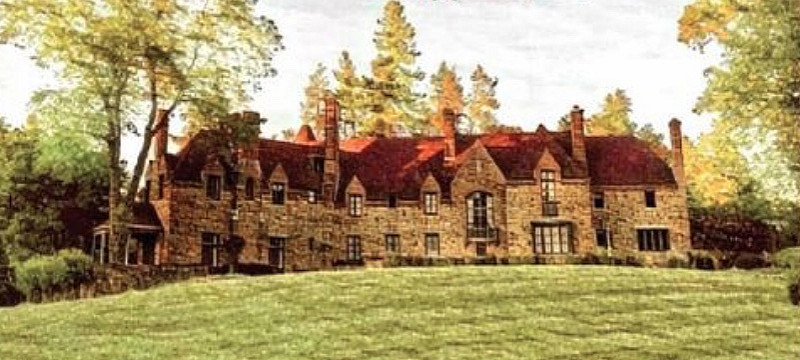Homewood
9002 Crefeld Street, Chestnut Hill, Philadelphia, Pennsylvania
Completed in 1930, for Lt.-Col. Schofield Andrews (1889-1971) and his second wife, Marie Sherman Disston (1890-1971). Replacing an earlier more modest house named "Homewood," it was designed by Tilden, Register & Pepper and has since become one of Chestnut Hill's best recognized mansions. It was built for a couple who were married in 1929 two years after each of them were widowed, but is best associated with the heiress who lost both her father and her brother on the Titanic. In 1969, it was donated to Temple University but since 1996 it has returned to being a private home....

This house is best associated with...
Lt.-Colonel Schofield Andrews was a grandson of John Schofield, U.S. Secretary of War and Commanding General of the United States Army from 1888 to 1895. His father was Brigadier-General of the American Expeditionary Forces and Colonel Andrews was one of the first to volunteer for overseas service in the First World War, winning the Distinguished Service Medal. He went on to have a successful career in Philadelphia as an attorney with Ballard, Spahr, Andrews & Ingersoll, but lost his first wife in 1927. Two years later, he was married again to the also recently widowed Mrs "Mimi" (Disston) Grant whose first husband, Patrick Grant II, had thrown himself from the fifth floor offices of Townsend, Whelen & Co. following a string of financial losses. The second Mrs Andrews was a grand-daughter of Henry Disston, founder of Disston & Sons, Saw Makers.
Having only just finished building a new house for his first wife at 424 Mermaid Lane, Andrews started afresh with a new house for his new wife and their combined four children. Replacing the original "Homewood" built forty years before for Mathew Carey Lea, Andrews employed Tilden, Register & Pepper to build them a new 30-room home.
Covering 18,000-square feet it is built with soft brown rubble stone and a clay-tile roof in the style of a Norman farmhouse. It is centered on three sides around a large courtyard and the front walls face Crefton Street. A third wing cornered by a conical tower topped by a weather vane protrudes diagonally into the 5-acre garden behind. The original interior was heavily influenced with Art-Deco features, eg., the colorful tiled wall fountain in the Flower Room with Art Deco animals and the Dining Room's floral fireplace.
From Counsel to Client
Covering 18,000-square feet it is built with soft brown rubble stone and a clay-tile roof in the style of a Norman farmhouse. It is centered on three sides around a large courtyard and the front walls face Crefton Street. A third wing cornered by a conical tower topped by a weather vane protrudes diagonally into the 5-acre garden behind. The original interior was heavily influenced with Art-Deco features, eg., the colorful tiled wall fountain in the Flower Room with Art Deco animals and the Dining Room's floral fireplace.
From Counsel to Client
Colonel Andrews was the counsel to Peter A.B. Widener (and several other members of the Widener family) and in 1949 he sold Homewood to one of his late client's recently divorced grand-daughters, Mrs Eleanor Elkins (Widener) Dixon. The original "Homewood" built by Mathew Carey Lea was almost certainly already known to Mrs Dixon as its owner from 1900 to 1926 (from whom Schofield Andrews bought the property) was her ex-husband's first cousin, Russell Thayer Jr. Hiring the architectural firm first established by Horace Trumbauer - the preferred architect of the Widener family - Eleanor set about refurbishing the interior to the designs of Trumbauer's protégé, Julian Abele.
The fireplace and 16th century oak-linenfold panelling that once adorned a hunting lodge belonging to King James I (1566-1625) of England were retrofitted into Homewood from the house in which Mrs Dixon had lived for the previous twenty-five years, Ronaele Manor. Otherwise, Mrs Dixon generally "French-ified" the interior, adding a Petit Trianon-style staircase in the entrance hall, larger windows, and rustic shutters.
Temple University, Then Back to Being a Home
The fireplace and 16th century oak-linenfold panelling that once adorned a hunting lodge belonging to King James I (1566-1625) of England were retrofitted into Homewood from the house in which Mrs Dixon had lived for the previous twenty-five years, Ronaele Manor. Otherwise, Mrs Dixon generally "French-ified" the interior, adding a Petit Trianon-style staircase in the entrance hall, larger windows, and rustic shutters.
Temple University, Then Back to Being a Home
Eleanor Dixon lived here with her son, Fitz Eugene Dixon, Jr. (1923-2006), his wife Edith and their two children. After Eleanor died, F.E. Dixon and his family continued to live here up until 1969 when they donated it to Temple University. Becoming known as the "Eleanor Widener Dixon House," the university renovated the property and it became one of three buildings that made up the "Albert M. Greenfield Conference Center".
In 1996, Homewood became a private residence again when it was purchased and restored by Bill and Ann Hozack. The seven bedroom, seven bathroom house with swimming pool, tennis court, bar, and bowling alley was most recently on the market for $2.5 million.
In 1996, Homewood became a private residence again when it was purchased and restored by Bill and Ann Hozack. The seven bedroom, seven bathroom house with swimming pool, tennis court, bar, and bowling alley was most recently on the market for $2.5 million.
You May Also Like...
Categories
Styles
Share
Image Courtesy of Zillow
Connections
Be the first to connect to this house. Connect to record your link to this house. or just to show you love it! Connect to Homewood →












